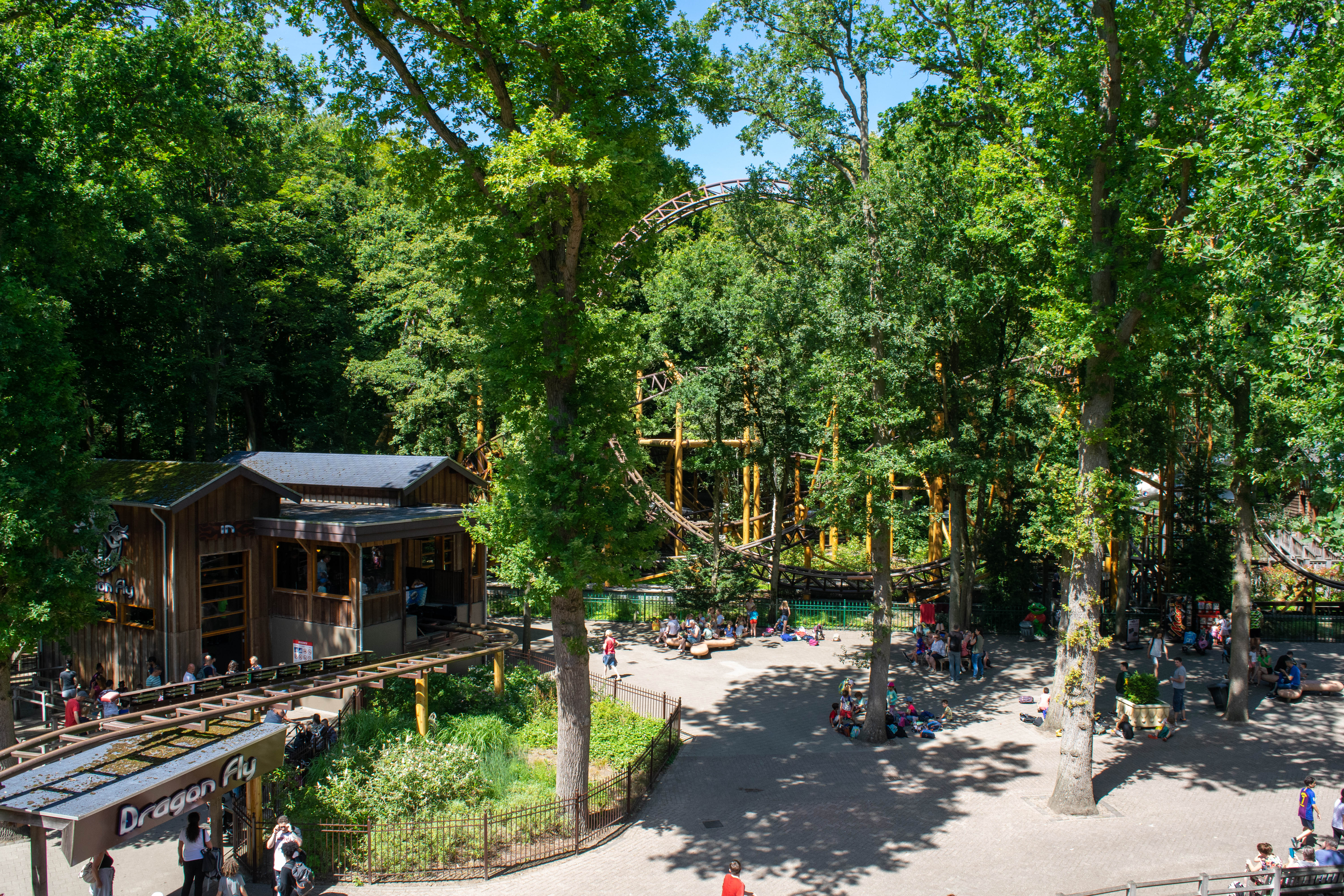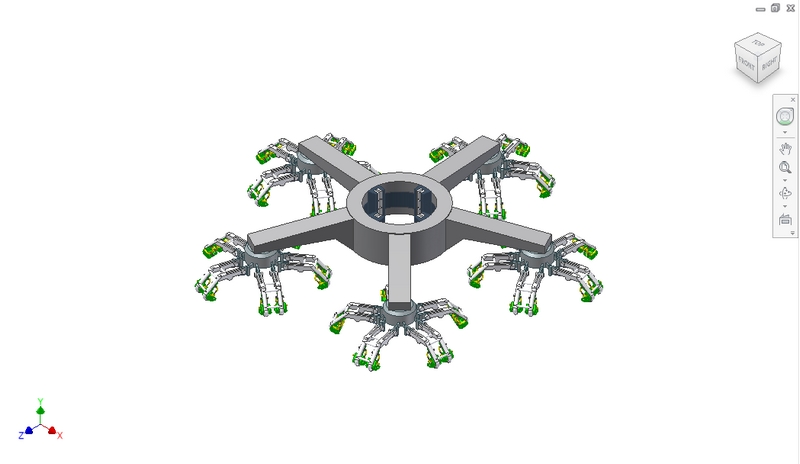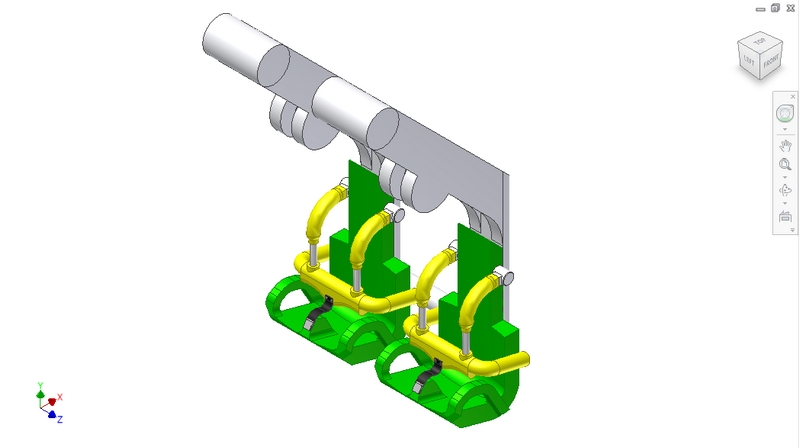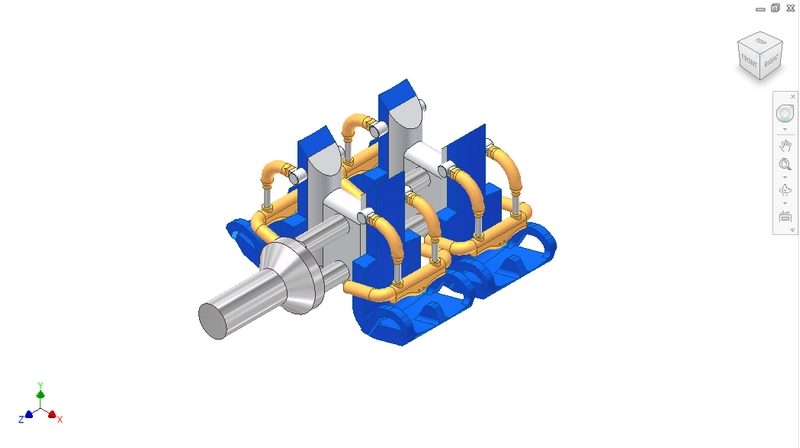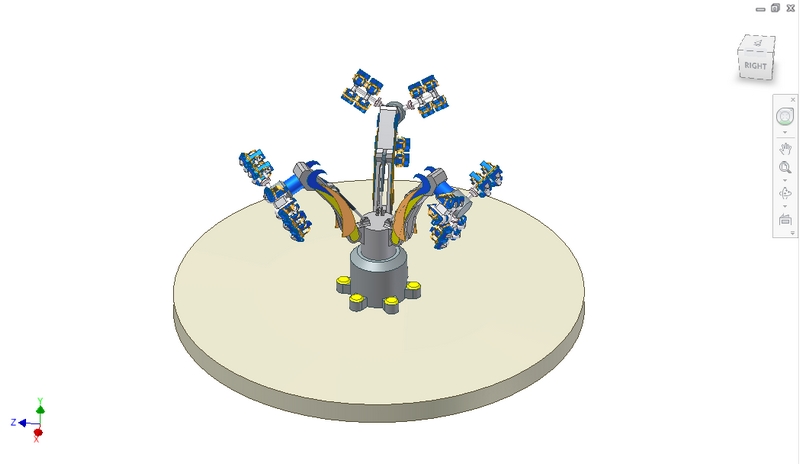-
Posts
7,069 -
Joined
-
Last visited
-
Days Won
23
Everything posted by A.J.
-
It was a five-sketch loft, then I made a new sketch on the top face for the extended seatback. Add some fillets and ta-da! Like VFB said before, going from IPT to 3DS is a very long and tedious process, and I have no knowledge of 3DSMax yet. Maybe soon, but for now - one miracle at a time. There's a new ride in the works! It's a quickie, and you'll instantly know what kind of ride it is. It'll be my last flat ride before I jump into the design of roller coaster trains! Two sets of seats, back to back. And now attach an arm with a counterweight. This should look very familiar if you go to carnivals (or ghetto fairs) often.
-
Yes - the Equinox is better known as a KMG Tango. Take an Intamin FLOORLESS stand-up drop ride, mix it with a Zamperla Power Surge or Zamperla Shocker, and that's what you've got. It is one of the most painful-in-all-the-wrong-places rides in existence.
-
You still need guide wheels to guide the car along the track, there cannot be any contact between the LIM stators and their receptive blocks on the vehicle. If you wish, you can send me the .ipt and .iam files and I could try to whip up a set of guide wheels for you. I will warn you though, I have the free student edition of Inventor, making files I make for you unsuitable for professional purposes. (I don't think that should be a problem, but I figured I should let you know.) I guess I'm not in the know about how LIM systems work...for constraint purposes, they will remain untouched. However, I did quickly add four large guide wheels, one on each "flat" side of the tower. Check it out...
-
^There are LIMs on both sides, so one set doesn't have to do all the work. And now, it's time for... NEW SEATS! Yes, I've got a brand-new seat design that's more comfortable then ever! Contoured seating. While the old design was relatively flat, this design is contoured to fit the human body more comfortably. The upper sides wrap around the rider's back. Two-piece seatback. The new seatbacks are made of two pieces instead of one - that makes the design more modular, less expensive (because of the gap in the middle), and easier to service. If one part of the seatback has been damaged, it can be replaced without having to replace the other piece. Boomerang lap restraint. Once again, it's countoured to the human body - all in the name of comfort. More restraint adjustability. The old restraints adjusted at the lap. Now, the new restraints also adjust at the shoulders, allowing riders of smaller height to ride. Everything from the old seat has been redesigned except for the frame - the frame only needed to be slightly modified. The presentation will be informal. This is the seat without the restraint attached. You can see how it's contoured. Now, with the restraint attached! You can clearly see how the lap restraint resembles a boomerang. Now, with the restraint opened. Here's how to get comfortable: 1. Lower the restraint over your head. 2. Press down on the lap restraint until it's comfortable on your lap. 3. Press down the shoulder pads until they're comfortable on your shoulders.
-
I have RCT3 Gold and the Wild expansion pack. On my PC that runs Vista Home Premium 32bit, the game works fine but the autorun doesn't come up when the disk is inserted.
-
Why fix something that works just fine? I doubt Holiday World will get a wood coaster from any other company than Gravity Group after all they did build them the #1 wood coaster. The ride's manufacturer/builder is only half of the equation. A huge amount of credit should be given to the designer(s) of the ride. It is possible for an Intamin, which would be considered by many to be one of the smoothest steel coasters around, to have a poorly designed layout. Although, for all I know, the Gravity Group could have its own design team - in that case the Gravity Group would get all the credit. If I were running an amusement park, I'd have my own design team - that way the ride would be good because it was designed by the park, and not because it was designed by a certain manufacturer.
-
After a month of work, let me present the Flying Falcon. The Flying Falcon is a twenty-first century interpretation of the legendary Huss Condor. Fifty riders, arranged in five circles of ten, are strapped into comfortable seats with restraints that can adjust to fit riders that are "more fat" the average person. Once all the riders are safe and secure, the three-and-a-half-minute ride begins. To start, each set of prongs starts to rotate counterclockwise. The prongs spin fast enough for centripetal force to raise the arms so that riders are facing at a 45-degree angle to the ground. The prongs are raised high enough that any rider can extend their legs and not touch the ground. After the prongs get spinning, the entire arm structure starts to rotate clockwise. Once the entire arm structure gets up to speed, the entire structure starts to rise up to the top of the ride's tower using linear induction motors. Once the structure is at the top, it remains there for most of the ride - with the arms rotating clockwise and the prongs rotating counterclockwise. As the ride nears its end, the arm structure and the sets of prongs stop spinning. Then, the entire ride is brought to the ground with a controlled free-fall - slow enough to easily stop but fast enough to startle riders and provide airtime. Specs: Approx. [D] of Prongs in Low Position: 16ft Approx. [D] of Arms in Low Position: 59ft Approx. [D] of Total Footprint: 68ft Approx. [A] of Total Footprint: 14500sqft Approx. [H] without top decoration: 96ft Approx. [H] with Top decoration: 103ft Passengers per prong: 2 Prongs per set: 5 Number of sets: 5 Total passengers per cycle: 50 Approx. passengers per hour: 850 COMING SOON: A new ride is on its way - but before that, I plan to debut a brand new seat/restraint design that is more open-air, less expensive, more modular, and more adjustable than the original. The Flying Falcon in its boarding position. The Flying Falcon in its raised position. This is a close-up of how the arm structure runs along the tower. Notice how there are LIMs on both structures - so that one structure's motor doesn't have to do all the work.
-
This will probably be the second-to-last update for this particular ride - it's coming together...FINALLY! No innuendos please...keep it clean. Here's the tower. The steel portion is 85 feet tall. The base is 8 feet, 6 inches tall for a total of 93 feet, 6 inches in height. Combination LIM runners and magnetic brakes line the edges of the tower. The girder tower is 8 2/3 feet across the diagonals wide, and the base is 17 1/3 feet in diameter. This is the top cap of the tower, complete with colored decorations that also light up at night, to be seen from everywhere in a park as well as for low-flying airplanes. The completed tower. There's only one thing left to do! Stay tuned!
-
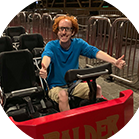
Alton Towers Discussion Thread
A.J. replied to Ed's topic in Theme Parks, Roller Coasters, & Donkeys!
"Rita: Queen of Darkness" anyone? -
Update... I'll have measurements when the ride is completely finished. The same assembly, but from a top-down perspective. This is the full arm assembly, minus decorative lighting. Total seating capacity is 50 passengers. The seats are currently in the most outward position. A close-up. The arm assembly uses a combination of linear induction motors (LIMs) and magnetic brakes to raise and lower the assembly. LIMs bring it up and magnetic brakes give it a controlled freefall downward. This is the large arm assembly.
-
Here are some images of the new ride! You won't be able to see what the ride really looks like until it's fully completed... When the prongs get spinning, centripetal force brings the arms up 45 degrees, with the seats facing 45 degrees downward. This part of the ride is what relates to Insanity The Ride. Five arms + ten pistons + one central unit. But...here's something new - a restraint belt. It's an essential safety feature. The belt is permanently attached to the restraint, and buckles to the seat. Here's an arm. The seats are modular, so the seat design is the same as on the Spin Surge. The arm is made from a seat frame extended higher and pitched at a 45 degree angle.
-
Once I truly master Inventor, 3DS Max is my next program to learn how to use. I need to start learning how to make CTRs and CFRs. And now... A teaser for the next ride! I am starting it from scratch (minus the seats and restraints - they're modular and therefore already finished). I'll give everyone "construction updates" as I go along this time. Insanity The Ride + Huss Condor = ?
-
Why thank you! I hope to be able to add height adjustability to the shoulder pads also, similar to S&S Power's system. The Zacspin coasters only flip on the forward-backward axis. That's why the cars need to be balanced. The curvature of the Zacspin track only tosses riders forward or backward. For rides like this, such as a Topscan, weight is tossed laterally as well as vertically. It's essentially a similar motion of a Moser Rides Flipping Action Arm, or a Moser Rides Twin Flip. As for a solution, while it would be difficult to incorporate a counter-balance system, I've got something else in mind. In the event of a potentially threatening weight balance, the operator would be able to set the ride in "face-up" mode, where the cars would automatically revert to the face-up, forward-sitting position for the rest of the ride. It's going to take me a long while to completely finish this model. While I have the rough model finished, I do not have any sort of interior components modeled, nor do I know completely how they work. I'm going to major in mechanical engineering, so hopefully I'll learn how the rides really work. That would be really cool if I could get my ride to be produced in real-life though. I may get back to you...
-
More pictures! If you have any questions, please ask them. If you have any suggestions, please suggest. If you want to see the ride from a different angle, please ask. If you want to see me produce a particular kind of ride, go ahead and ask! I may decide to model one. This is the seat assembly. The restraint lap portion is height adjustable. That way, it can accomodate guests of a larger size and still reach to their lap. Close-up of one of the arms with the seats flipping freely. Isometric view with the arms in the seventy-degree position. The seats aren't flipping right now, though. Side view. You can see that the seats have been raised. That allows for seat flipping in the horizontal position. View from a top-down perspective. The diameter of the ride's footprint is 58 feet. Isometric view of the entire ride. The ride is in the horizontal position. The seats lower about three feet when it's time for guests to unload and load.
-
My dream is to become a staple designer in the amusement park industry. Roller coasters, water rides, waterslides, flat rides...everything! RCT is limited. NoLimits is...limited. I wanted to experiment with software that has no limits. Enter Autodesk Inventor. Using Inventor, I have created a cool flat ride called Spin Surge. Take a Fabbri Hard Rock... Mix in a Tivoli Re-Mix... ...and you've got my original ride, Spin Surge! It combines a clockwise-spinning central body and arms, counter-clockwise spinning under-arms (like a scrambler), free-flipping seat assemblies, and raising and lowering central arms. More pictures, including pictures of the ride in all positions, are coming soon. For now... Do you have the stomach to handle Spin Surge?
-

Conversion from RCT2????
A.J. replied to Intimidator305kd's topic in Roller Coaster Games, Models, and Other Randomness
RCT2 parks will not work in RCT at all. However, in RCT2's scenario editor, you can load a saved game from RCT1 and it can be used as a landscape file (minus rides and shops of course). All you would have to do is make it a scenario and replace all the rides and shops. -
When I use wide auto supports (I refuse to hand-build every support) on a track with terrain, the nodes do not follow the terrain. Instead, the nodes are placed as if the ride has no terrain at all. That makes footers appear on the terrain with nothing visible attached to them. Anyone know what I'm talking about and can help?
-

The "Preview" Thread
A.J. replied to DBru's topic in Roller Coaster Games, Models, and Other Randomness
Here's a new one coming soon from me...still have a little bit of cleaning to do. -
POV Video is up! [coastertube]http://www.themeparkreview.com/coastertube/play.php?vid=Take_a_ride_on_FRENZY_gmra[/coastertube] Download is up too! Frenzy.nltrack Okay, it's not GeForce or Bizarro, but I think it's pretty close to their level...
-
It's been a while! Frenzy is on the home stretch of being completely finished. Here are some shots before I load up a video and a download. IMG tags are just easier for me: Frenzy is sporting a brand spanking new color scheme. You can now see that the entire ride is surrounded by trees. Oooh! Station fly-by! Take that, GCI! Here's a look at the custom station. Frenzy is running in three-train operation. Video and download coming soon!

